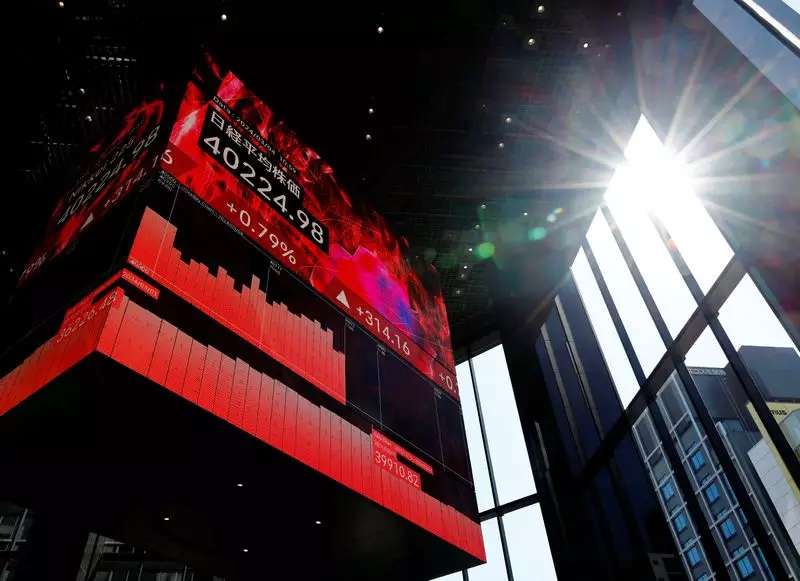As the new week unfolds, financial markets are exhibiting a sense of caution, particularly in Asia, where trading activity has been noticeably subdued. Despite the overall sentiment, there was a glimmer of recovery reflected in MSCI’s broadest index of Asia-Pacific shares outside Japan, which rose by 0.7%. This uptick comes after the index experienced a downturn that marked a five-week low just prior. Such fluctuations underscore the complexity and unpredictability inherent in global finance; they are not merely a reflection of regional developments but a response to multifaceted international economic signals.
The dollar has shown some signs of easing, a trend that traders often scrutinize as part of their strategies in anticipation of significant economic events. As traders prepare for a week that promises key monetary policy announcements, including those from the Federal Reserve and various other central banks, the market dynamics may shift dramatically. With upcoming events such as the U.S. presidential race looming heavily, predicting market reactions becomes even more intricate.
The approaching U.S. elections are destined to have far-reaching consequences on financial markets, especially as polls begin to reflect shifting sentiments among voters. A recent poll indicating Democratic candidate Kamala Harris’s unexpected lead in Iowa has sparked discussions about market volatility. Although both she and incumbent Republican candidate Donald Trump remain closely matched in favorability with voters, Harris’s rise has altered market perceptions, particularly regarding the so-called “dollar Trump trade.”
Market analysts, such as Tony Sycamore from IG, have noted a notable decrease in the projected probability of a Republican sweep in the elections—from 48% to approximately 36%. Understanding these probabilities is essential, as they play a crucial role in shaping market sentiment and potential investment strategies. Investors must also factor in the notion that Trump’s potential policies—focused on immigration, tax cuts, and tariffs—could lead to inflationary pressures, a surge in bond yields, and a strengthening dollar, all of which have significant implications for trading strategies globally.
However, the near-equal standing in opinion polls suggests a high likelihood of unpredictability post-elections, with final outcomes potentially taking days to ascertain. This uncertainty naturally incites caution among market participants, triggering defensive maneuvers as they navigate through an industrial landscape that could change dramatically with the advent of new policies.
Beyond the U.S. election spectacle, investors are attentive to monetary policy announcements from various central banks, with the Federal Reserve taking center stage. Analysts largely expect a 25-basis-point rate cut as a means of fostering growth in an uncertain economic climate. This anticipated cut aligns with the current economic indicators that suggest a cautious approach is warranted, especially given the fiscal uncertainties associated with the impending election.
The Bank of England (BoE) is also scheduled to announce its rate decisions, with expectations leaning towards an easing strategy following a tumultuous week marked by a sell-off in gilts. The volatility surrounding the British pound has been notable, with indicators suggesting a potential recovery aided by a weaker dollar. However, despite the increase, the pound’s previous declines signal broader instability within the UK economy.
Meanwhile, other central banks in Australia and the Nordic region will similarly converge this week to deliberate on their monetary trajectories. Markets are keenly aware that decisions made during these meetings will have a domino effect on global markets.
For Asia, one of the focal points lies with China’s National People’s Congress (NPC), which possesses the potential to unveil strategies aimed at revitalizing its economy. Recent reports suggest that the Chinese government is contemplating the approval of over 10 trillion yuan in extra debt as part of a fiscal package designed to stimulate growth. However, caution has been advised, as analysts warn that transferring debt to the central government may not significantly enhance overall demand.
The interplay between China’s economic strategies and global market reactions is profound. Should the NPC introduce measures that promote genuine fiscal stimulus, we may see renewed investor confidence reflected in market indices across Asia. Conversely, if the anticipated policies are perceived as insufficient, the existing uncertainties may prevail, dampening market enthusiasm.
Commodities Market Reaction and Future Outlook
In the commodities sector, fluctuations in oil and gold prices also warrant attention. A recent decision by OPEC+ to delay an output hike has caused oil prices to climb, positively impacting WTI and Brent crude benchmarks. The resilience of oil amid geopolitical tension and economic uncertainty illustrates the volatile nature of this market segment.
On the other hand, spot gold’s modest gains indicate investors’ hesitance to entirely distance themselves from safe-haven assets. The interplay between economic data, monetary policies, and political events will continue to guide investor behavior and will likely dictate the trajectory of the commodities market in the near future.
This week stands as a pivotal juncture for global markets, with a confluence of political events and economic indicators shaping sentiments and investment strategies. Understanding these dynamics is essential for navigating the intricacies of financial markets as we proceed into an uncertain economic landscape.

